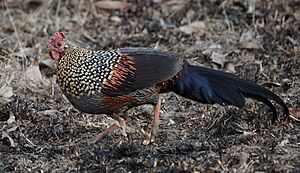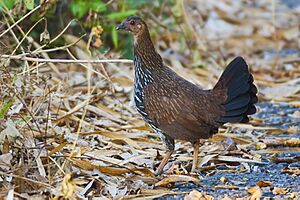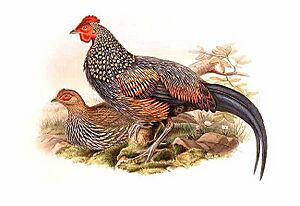Grey junglefowl facts for kids
Quick facts for kids Grey junglefowl |
|
|---|---|
 |
|
| Cock in Bandipur National Park | |
 |
|
| Hen in Thattekad Bird Sanctuary | |
| Conservation status | |
| Scientific classification | |
| Genus: |
Gallus
|
| Species: |
sonneratii
|
 |
|
| Actual spot records and presumed distribution | |
The grey junglefowl (Gallus sonneratii), also known as Sonnerat's junglefowl, is a wild bird. It is one of the ancestors of the domestic chicken. Other ancestors include the red junglefowl and other junglefowls.
The name Sonnerat's junglefowl honors Pierre Sonnerat. He was a French explorer. People in India have many names for this bird. Some local names are Komri in Rajasthan and Jangli Murghi in Hindi. In Tamil and Malayalam, it's called Kattu Kozhi.
Contents
What the Grey Junglefowl Looks Like

The male grey junglefowl is very colorful. It has a black "cape" of feathers on its back. These feathers have cool ochre (yellow-brown) spots. The rest of its body feathers are grey with fine patterns.
Its long neck feathers are dark. They end in a small, hard, yellowish tip. These special feathers are popular for making high-quality artificial flies for fishing.
The male has red wattles and combs, like a chicken. However, they are not as big as those on the red junglefowl. Male grey junglefowl have red legs with spurs. Females have yellow legs and usually no spurs. The male's central tail feathers are long and curved like a sickle.
Males change their feathers in summer. They lose their colorful neck feathers after the breeding season. This is called an eclipse plumage. The female grey junglefowl is less colorful. She has black and white stripes on her belly.
Where Grey Junglefowl Live
This bird lives only in India. You can find them mostly in the southern part of India. They also live in Gujarat, Madhya Pradesh, and southern Rajasthan.
They like to live in thick bushes, on the forest floor, and in open scrub areas. The red junglefowl lives more in the foothills of the Himalayas. The grey junglefowl and red junglefowl sometimes live in the same areas, like the Aravalli Range.
Different Types of Grey Junglefowl
Some people think the grey junglefowl from Mount Abu in Rajasthan is a different type. They call it wangyeli. Its calls might sound different from birds in southern India. Also, its feathers might be paler. But most experts do not officially recognize this as a separate subspecies.
Behaviour and Life Cycle
Grey junglefowl make loud, clear calls. They sound like Ku-kayak-kyuk-kyuk. You can hear them early in the morning and at sunset. Unlike the red junglefowl, the male does not flap its wings before calling.
They usually breed from February to May. Females lay 4 to 7 eggs. The eggs are a pale creamy color. They lay them in a simple nest on the ground. The eggs hatch in about 21 days.
Even though they spend most of their time on the ground, grey junglefowl can fly into trees. They do this to escape from predators. They also roost (sleep) in trees at night. They look for food in small groups. These groups can be all males, all females, or mixed.
They eat different kinds of food. This includes grains, like bamboo seeds, and berries. They also eat insects and termites. People sometimes hunt them for their meat. Their long neck feathers are also wanted for making fishing lures.
Relationships with Other Birds
Grey junglefowl have been raised in captivity in England since 1862. Their feathers have been sold for fly tying since 1978.
A special gene from the grey junglefowl gives domestic chickens their yellow legs and other yellow body parts. This shows how closely related they are. Scientists have also found that some genes from grey junglefowl are now in domestic chickens. And some domestic chicken genes are found in grey junglefowl.
Sometimes, grey junglefowl and red junglefowl breed together in the wild. This is called hybridizing. They can also hybridize with domestic chickens that live near forests.
Scientists believe the grey junglefowl and red junglefowl became separate species about 2.6 million years ago. The grey junglefowl is also closely related to the Sri Lankan junglefowl. They separated about 1.8 million years ago. This suggests they are "sister species."



